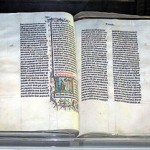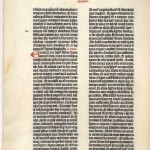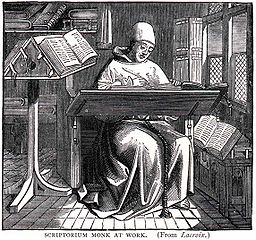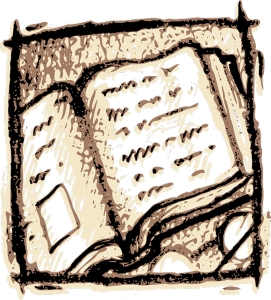By Milena Brunetta and Kyle Stooshnov
In the early 1840’s, there was a convergence of events happening in England to produce a masterpiece that has never been out of print since first being published in 1843. Since this time, Charles Dickens’ novella A Christmas Carol has been adapted and remediated into other formats, including public readings, film, radio plays, live television broadcast and staged productions. Paul Davis (1990), author of The Lives and Times of Ebenezer Scrooge, coined a new term to discuss this story as a “culture-text” that people continue to recreate and retell every Christmas (p. 4). In examining the development of literate technologies, in this case from printed text to motion picture, it will be revealing to consider the convergence of events that first brought about the text itself.
A good book is like holding on to a cup of coffee or tea. It warms you up from the outside in, it is hard to let go when the flavor is just right, and it can take your thoughts to a place you didn’t think you would ever go. Throughout the ages, books of all genres have captured the attention of millions. As a result, many believed such great works must in some way be paid homage to through film. One of these well-known novels, of which you will find hundreds of different adaptations for, is A Christmas Carol by Charles Dickens. As Leitch (2007) explains “adaptation theory, the systematic study of films based on literary sources, is one of the oldest areas in film studies” (p. 1). It is, therefore, not surprising that the argument about whether it is the book or the movie that should receive the highest honor, continues to stir people’s thoughts and opinions.
As you’ve heard many times before, and have probably said at least once in your life – the book was better than the movie. Why is the latter such a frequent statement? Can a movie depict all that is contained in the hundreds of pages, and thousands of words that line the paper, that makes up a book? Many argue that it is not possible. Leitch also says that “no matter how clever or audacious an adaptation is, the book will always be better than any adaptation because it is always better at being itself” (p. 16). This makes perfect sense, as the book was made not to be a film, but to be a book. It was not made with the intention of becoming a movie. It was made with the intention that it would be the best possible book it could be, on its very own. The book was made with a certain vision in mind. A vision, in which those who read it will be captured by the wording that so easily allows them to visualize and connect with the characters within it. Furthermore, Leitch explains that “fidelity as a touchstone of adaptations will always give their source texts, which are always faithful to themselves, an advantage so enormous and unfair that it renders the comparison meaningless. To evaluate adaptations fairly, we need to evaluate their source texts as well” (p. 16).
The first of three converging event happened prior to 1843, when a new technology from France literally changed the way people would see the world. On August 19, 1839 at a joint meeting of the Academy of Science and Academy of Fine Arts in Paris, photography was presented and its inventor, Louis-Jaques-Mandé Daguerre, received a life-long pension from the French government providing that he fully publish the photographic process. That summer, “Daguerre was quietly working with an agent in Britain to patent his process there,” and within a few decades, both cameras and photographs were on display at London’s Crystal Palace, the iconic home of the Great Exhibition of the Works of Industry of All Nations in 1851 (Marien, 2011, p. 25). Two significant supporters of photography were Queen Victoria and Prince Albert, who became patrons of the Photographic Society of London shortly after its foundation in 1853. With this important advancement in the representation of human activity, the royal couple makes a second part of the convergence of events leading to the creation of A Christmas Carol, particularly the popularization of the Christmas traditions in England.
Christmas Tree at Windsor Castle (1848)
Before marrying her cousin the Duke of Saxe-Coberg and Gotha in 1840, the young Queen Victoria got an Act of Parliament to naturalize the German Prince Albert. With his immigration to England he brought the German custom of decorating a Christmas tree inside the home. This tradition was a sombre event and the start of a renewed interest in the holiday traditions which helped bring cheer and goodwill to many during the Industrial Revolution. A few years after the Great Exhibition, a decorated Christmas tree was placed inside the Crystal Palace (Thomas, n.d.). Today, it is a common sight in December to see lavish decorated trees in countries observing the Christian holy day as well as non-Christian countries, something which Prof. Dr. Gabriella Mazzom (2011) points out as “the recreation of European world in the new land” arising from the naval and imperialistic practices of England in the late nineteenth and early twentieth centuries (lecture Christmas at a Distance) . As Christmas became a world-wide event, it is impressive to notice how close to the inception of the modern holiday that Charles Dickens recognized its social impact, and could write his story which celebrates not only the outward symbols and traditions of Christmas, but also makes a moral message about the spirit of goodwill and generosity for all ages.
In Bolter’s (2011) description of the rhetorical term ekphrasis, where “prose tries to represent images,” as well as other sensory experiences, he mentions the writer’s “desire to capture the world in the word” challenged by visual media such as photography (p. 56). Dickens had established himself as an artist of daily life in England, first by publishing pseudonymously Sketches by “Boz” between 1833 and 1836, when photography was still a nascent technology. Nearly all of his writing makes use of illustrations printed alongside his text; in the few cases where illustrations were not used, the titles alone suggest the ekphrasis of his words: American Notes [punningly referring to banknotes] for General Circulation (1842) and Pictures of Italy (1846). Even with the use of illustrations, the novels of Dickens subordinate images to the words he wrote.
His first journey to the United States and Canada in 1842, chronicled in American Notes and later fictionalized in Martin Chuzzlewit (1843), may have inadvertently helped with the creation and popularization of A Christmas Carol, the first of many Christmas-themed stories. Dickens had visited prisons, hospitals and other institutions during his travels, making note of the innovative approach to charity. Eventually he became distressed by the other American institution, slavery, and created this vivid picture of a still-legal practice in the United States: “Thus the stars wink upon the bloody stripes; and Liberty pulls down her cap upon her eyes, and owns Oppression in its vilest aspect, for her sister” (Dickens, 2004, p. 328). Some word-pictures were too much for his readers, and while his American Notes was successful, if highly criticized for anti-Americanisms, Martin Chuzzlewit did not sell as well as his other novels. At this low point in his career, along with more positive events converging upon the fall of 1843, he writes a story structured as a song, otherwise known as his carol.
Dickens started writing this Carol “on 3 October, still in the midst of Chuzzlewit,” writes biographer Simon Callow (2012) of the chapters following the above quoted line, “just at the point where Martin, sunk in despair at the ruin of his hopes for Eden [a town in the United States], begins to will himself dead,” in a state perhaps mirroring the financial and psychological distress of the author (p. 139) . Another starting point was Dickens’ realization that Want and Ignorance were the chief causes of much misery, and his Carol was an attempt to raise consciousness in England, as well as the English-speaking world. Choosing what was supposed to be a harmonious time of the year, thanks largely to Prince Albert’s influence, he writes about spirits reforming the soul of an embittered miser named Scrooge. The next day after starting this “little Carol”, as Dickens fondly calls his story, he attended the Manchester Athenaeum Society meeting. In part of his speech to a crowd of dignitaries as well as working class members, he rails against Want and Ignorance:
…my own heart dies within me when I see thousands of immortal creatures condemned without alternative or choice, not to what our great poet once calls ‘the primrose path to the everlasting bonfire’, but one of jagged flint and stones, laid down by brutal ignorance. (cited in Callow, 2012, p. 139-40)
His invocation of Shakespeare’s play Macbeth will be one of the numerous allusions to this and other plays in A Christmas Carol. Such dramatic flourishes are consistent with Dickens’ style of writing, and make the most of the celebrity status of the Renaissance playwright during the 19th century (see Collins, 2009; Shapiro, 2005). As Dickens seems to have gained a celebrated reputation in the United Kingdom as a writer, a decade following the well-received (yet not as profitable as he hoped due to legal troubles with publishers) Carol, he begins to adapt this and scenes from other stories into public readings. His side career as performer touches upon “the lingering feeling for the old oral narrator’s world” (Ong, 2002, p. 146). Yet, as Callow asserts in his biography, Dickens “wore himself out and laid the groundwork for an early grave in the process” (Petrie, 2012, p. 290). Despite all this tragedy, Dickens’ story would continue to thrive; from novel to stage, from radio to film, his words has been made immortal.
https://www.youtube.com/watch?v=C5Kh754TYo0
One of the most significant changes to the performance text which Dickens adapted made the story shorter. Originally written in five staves, roughly 20 pages each, he condensed his story into four, usually with a ten minute intermission midway through the public reading. Andrews notes that the changes Dickens made highlight the festive Christmas gatherings like Fezziwig’s ball and the Cratchit’s dinner “whereas the episode involving those emblematic victims of social neglect, Want and Ignorance, disappears” (p. 82). So, something arguably crucial to the creation of the story gets left out, despite the effort Dickens made to ensure that people from diverse social classes could afford to attend his readings. He was not shying away from harsh social commentary either, as “Nicholas Nickleby at the Yorkshire School”, “Mrs Gamp” from Martin Chuzzlewit and after his second trip to the United States in 1867 “Bill Sikes’ murder of Nancy” from Oliver Twist were frequently performed at public readings. Kate Field (1998), an American journalist who attended 25 of the 76 performances Dickens gave in the United States, comments on his style in her book Pen Photographs:
I have photographed them [Dickens’ readings] with the hope of clinching their recollection in the minds of many, and of giving to others some faint outline of a rare pleasure, the like of which will ne’er come to us again. Now that the great man has “vanished forevermore” from the “garish lights” of St. James Hall, the republication of this book [Pen Photographs], in an enlarged and more durable form, is deemed opportune…(Preface, p. xix)
Not only has she remediated the readings of Carol and other stories with the metaphor of photography, “Taken from Life” is the book’s subtitle, but also writes about the experience of seeing Dickens live and her attempt to capture these moments as an example of Davis’ culture-text, “a text that permeates the cultural consciousness… and a text that metamorphoses in the making” (John, 2010, p. 211) as well as an early example of literary adaptation in new media.
Boozer (2008) explains that “literature-to-film adaptation involves the textual transposition of a single-track medium of published writing into a document that embraces the scenic structure and dramatic codes of the multitrack medium of film” (p. 1). Therefore, it is imperative that the screenplay includes the multifaceted aspects that are involved in the production of the film. It is, therefore, no surprise that not every single word of the novel can be transcribed into the movie. The visual effects and imagery eliminate many of the descriptive words used in a novel because movies can take these words and bring them to life, visible for the naked eye. However, can and will all aspects of the film be identical to what has been envisioned by the reader of the novel? The answer is simple, no. The reason this is so, is because when one reads a novel the way they interpret the words written on the page, and transform them into visuals in their minds differs. So, it is “the composition of the screenplay [that] illuminates the evolution of ideas that will determine the film production’s relationship to its source text.” (Boozer, 2008, p.1)
Charles Dicken’s A Christmas Carol is a novel that has been adapted time and time again. Guida (1991) explains that since 1901, there have been 170 English adaptations of the book into film, television, and animation. With so many different adaptations there are bound to be some that follow the novel extremely closely, others that are loosely based on the novel, and others that try to expand on the novel. The 1951 adaptation of A Christmas Carol is “an artistic work that is different from the text because it extends the novella rather than being a literal adaptation” (Potter 2003, p. 3). Potter (2003), as well as Guida (1991) concur that the 1951 adaptation is one of, if not the best adaptation, in that it goes beyond the written words of the text and “attempt[s] to psychoanalyze Scrooge [where] many details of his background are filled in (or created) in an effort to explain him” (para. 9). As Potter (2003) states “the script uses Scrooges’ relationships with women as the vehicle, to show why [he] transforms from a principled, lovable young man” to one that is bitter and arrogant (p. 20). The 1951 version includes a “memorable blend of Victorian bric-a-brac, beautifully atmospheric cinematography and music and a host of superb character performances…that justifies the film’s high reputation” (Guida, 1991, para. 9).Working with any novel, and even more so, one as complex as Dickens’, it is nearly impossible to make a film that is the “exact translation of Dickens’ text” (para. 10). It is evident that parts were omitted and the sequence of certain events changed in the timeline. However, Guida says that he “suspect[s] it is exactly what Dickens had in mind in its grasp and graphic depiction of the human degradation and social injustice that he was crusading against” (para. 10). Therefore, “whatever the Carol’s intrinsic value as great literature and great entertainment, or as the basis for many memorable films, we inevitably return to its message.” (para. 30) And so, it is perhaps this that we must ask ourselves after watching the film that was created based on a novel; Is the message the novel conveyed clearly defined in the film?
References:
Andrews, M. (2006) Charles Dickens and his performing selves: Dickens and the public readings. Oxford: Oxford U P. Retrieved from http://site.ebrary.com/lib/ubc/Doc?id=10271503&ppg=97
Bolter, J. D. (2011). Writing Spaces. New York: Routledge.
Boozer, J. (2008). Authorship in film adaptation. http://site.ebrary.com/lib/ubc/docDetail.action?docID=10273761&p00=authorship%20film
Callow, S. (2012). Charles Dickens and the great theatre of the world. New York: Vintage Books.
Davis, P. (1992). The life and times of Ebenezer Scrooge. New Haven: Yale U. P.
Guida, F. R. (1991). Charles Dickens’ A Christmas Carol. Films in Review, 42(11/12),
362-369. Retrieved from http://web.ebscohost.com.ezproxy.library.ubc.ca/ehost/detail?sid=45eaa343-1d7c-4fdc87c56380dc4cb1ad%40sessionmgr10&vid=1&hid=14&bdata=JnNpdGU9ZWhvc3QtbGl2ZQ%3d%3d#db=aph&AN=9706166233
DIckens, C. (2004). Martin Chuzzlewit. Ed. by Patricia Ingham. London: Penguin Books.
John, J. (2010). Dickens and mass culture. Oxford: Oxford U. P.
Leitch, T. M. (2007). Film adaptation and its discontents: From Gone with the Wind to the Passion of the Christ. http://site.ebrary.com/lib/ubc/docDetail.action?docID=10256337
Marien, M. W. (2011). Photography: A cultural history. Upper Saddle RIver: Prentice Hall.
Mazzon, G. (2011, Dec 2). “Christmas at a distance: The sociohistorical pragmatics of British and extraterritorial Christmas” [lecture]. Leopold-Franzens-Universität, Innsbruck.
Ong, W. (2002). Orality and literacy. New York: Routledge.
Petrie, G. (2012). Dickens at 200. Journal of European Studies, September, 42.
Potter, W. J. (2003). “A Christmas Carol”: An analysis of two media. California State University, Dominguez Hills. ProQuest Dissertations and Theses, , 51-51 p. Retrieved from ttp://ezproxy.library.ubc.ca/login?url=http://search.proquest.com/docview/250016128?accountid=14656.
Thomas, P. W. (n.d.) “Christmas traditions – Christmas tree customs” Fashion-Era [website]. Retrieved from http://www.fashion-era.com/Christmas/christmas_customs_tree_history.htm#Prince_Albert_in_1841











